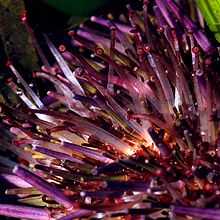Strongylocentrotus purpuratus
| Strongylocentrotus purpuratus | |
|---|---|
 | |
| Scientific classification | |
| Kingdom: | Animalia |
| Phylum: | Echinodermata |
| Class: | Echinoidea |
| Subclass: | Euechinoidea |
| Superorder: | Echinacea |
| Order: | Echinoida |
| Family: | Strongylocentrotidae |
| Genus: | Strongylocentrotus |
| Species: | S. purpuratus |
| Binomial name | |
| Strongylocentrotus purpuratus (Stimpson, 1857) | |
 | |
| Strongylocentrotus purpuratus range | |


The purple sea urchin, Strongylocentrotus purpuratus, lives along the eastern edge of the Pacific Ocean extending from Ensenada, Mexico to British Columbia, Canada.[1] This sea urchin species is deep purple in color and lives in lower intertidal and nearshore subtidal communities.
It normally grows to a diameter of about 4 inches and may live as long as 70 years.[2]
Role in biomedical research
Strongylocentrotus purpuratus is one of several biomedical research models in cell and developmental biology.[3] The sea urchin is the first animal with a sequenced genome that (1) is a free-living, motile marine invertebrate; (2) has a bilaterally organized embryo but a radial adult body plan; (3) has the endoskeleton and water vascular system found only in echinoderms; and (4) has a nonadaptive immune system that is unique in the enormous complexity of its receptor repertoire.[4]
Its genome was completely sequenced and annotated in 2006.[4] The sea urchin genome is estimated to encode about 23,300 genes. Many of these genes were previously thought to be vertebrate innovations or were only known from groups outside the deuterostomes.
Thus the sea urchin genome provides a comparison to our own and those of other deuterostomes, the larger group to which both echinoderms and humans belong.[4] Using the strictest measure, the purple sea urchin and humans share 7,700 genes.[5] Many of these genes are involved in sensing the environment,[6] a fact surprising for an animal lacking a head structure.
Ecology and economics
The purple sea urchin, along with sea otters and abalones, is a prominent member of the spectacular kelp forest community.[7] Sea urchins have been used for food by the indigenous peoples of California. They ate the yellow egg mass raw.[8][9]

See also
- Arbacia punctulata, the Atlantic purple sea urchin
References
- ↑ Ricketts EF, Calvin J. Between Pacific Tides. 3rd Rev. edn. 1962 by J.W. Hedgpeth. XII 516. Stanford University Press, Stanford, CA. 1939
- ↑ T.A. Ebert, J. R. Southon, 2003. Fish. Bull. 101, 915
- ↑ SU White Paper
- ↑ 4.0 4.1 4.2 Sodergren, E.; Sodergren, G. M.; Weinstock, E. H.; Davidson, R. A.; Cameron, R. A.; Gibbs, R. C.; Angerer, L. M.; Angerer, M. I.; Arnone, D. R.; Burgess, R. D.; Burke, J. A.; Coffman, M.; Dean, M. R.; Elphick, C. A.; Ettensohn, K. R.; Foltz, A.; Hamdoun, R. O.; Hynes, W. H.; Klein, W.; Marzluff, D. R.; McClay, R. L.; Morris, A.; Mushegian, J. P.; Rast, L. C.; Smith, M. C.; Thorndyke, V. D.; Vacquier, G. M.; Wessel, G.; Wray, L.; Zhang, C. G. (2006). "The Genome of the Sea Urchin Strongylocentrotus purpuratus". Science 314 (5801): 941–952. doi:10.1126/science.1133609. PMC 3159423. PMID 17095691.
- ↑ Materna, S.C., K. Berney, and R.A. Cameron. 2006a. The S. purpuratus genome: A comparative perspective. Dev. Biol. 300: 485-495.
- ↑ Burke, R.D., L.M. Angerer, M.R. Elphick, G.W. Humphrey, S. Yaguchi, T. Kiyama, S. Liang, X. Mu, C. Agca, W.H. Klein, B.P. Brandhorst, M. Rowe, K. Wilson, A.M. Churcher, J.S. Taylor, N. Chen, G. Murray, D. Wang, D. Mellott, R. Olinski, F. Hallböök, M.C. Thorndyke. 2006. A genomic view of the sea urchin nervous system. Dev. Biol. 300: 434-460.
- ↑ Pearse, J. S. 2006. The ecological role of purple sea urchins. Science 314: 940-941.
- ↑ D. Sweetnam et al., Calif. Coop. Oceanic Fish. Invest. Rep. 46: 10 (2005).
- ↑ http://books.google.com/books?id=jpvrxVA0PGYC&pg=PA91&dq=%22Strongylocentrotus+purpuratus%22+native&hl=en&sa=X&ei=-446UbD_L6mH0QH9p4GYBg&ved=0CE4Q6AEwBg#v=onepage&q=%22Strongylocentrotus%20purpuratus%22%20native&f=false